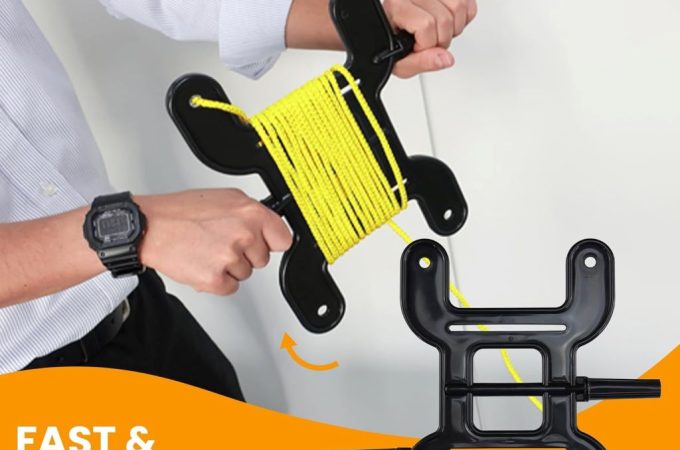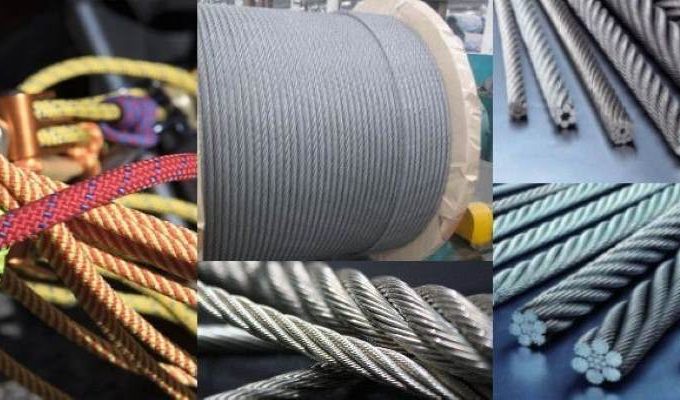
Static Rope: Unleash the Power and Versatility!
Static rope is a type of rope that is designed to be strong and sturdy, making it suitable for tasks such as rock climbing and rescue operations. Static rope, also known as low-stretch rope, is a durable and robust type of rope that offers excellent strength and minimal stretch.
Contents at a Glance
ToggleIt is commonly used in activities where safety and stability are paramount, such as rock climbing, caving, and rescue operations. Unlike dynamic ropes, which are designed to absorb energy from falls, static ropes are not intended to stretch, making them less suitable for situations where a fall might occur.
With their high strength and low elongation capabilities, static ropes provide reliable support and can withstand heavy loads. They are typically made from materials like nylon or polyester and often have a kernmantle construction for added durability. Whether you’re scaling a cliff face or rescuing someone in need, a static rope is a dependable tool you can rely on.
Unleashing Static Rope’s Potential
Static rope, with its remarkable attributes and versatility, has become a game-changer in various adventurous activities. Whether you are engaging in rock climbing, caving, or rescue operations, static rope has proven to be a valuable companion in overcoming challenging terrains. This section explores the essence of static rope in adventurous activities, why it is favored over dynamic ropes in certain scenarios and the key properties that define its performance.
The Essence Of Static Rope In Adventurous Activities
Static rope plays a pivotal role in ensuring the safety and success of adventurers and professionals alike. Its primary characteristic lies in its minimal stretch. Unlike dynamic ropes that are designed to absorb energy from falls, static ropes are constructed to have negligible stretch. This feature is crucial in scenarios where stability and control are paramount, such as when rappelling down steep cliffs or traversing delicate cave systems.
With its low-stretch quality, static rope provides adventurers with a firm and predictable platform to navigate treacherous environments. Furthermore, its durability and robust construction enhance its ability to withstand abrasions, making it ideal for sustained use in challenging conditions.
Why Static Ropes Are Favored Over Dynamic Ropes In Certain Scenarios
In specific situations, static ropes outshine their dynamic counterparts due to their unique properties. The minimal elongation inherent in static ropes ensures greater control and precision in technical maneuvers. This is especially advantageous when undertaking high-angle rescues or rigging operations where accuracy and stability are non-negotiable.
Moreover, the reduced stretch eliminates the risk of drastic impact forces encountered during falls that can occur during rope ascents, descents, or traversals. Static ropes provide a reliable safety net, minimizing the potential for equipment damage and unnecessary injuries.
Key Properties That Define Static Rope’s Performance
The performance of static rope can be attributed to several key properties that distinguish it from other rope types. These properties are:
- Minimal stretch: Static rope’s limited elasticity ensures enhanced stability and control during technical maneuvers.
- Durability: Static ropes boast exceptional resistance to abrasions and wear, ensuring longevity under demanding conditions.
- Strength: Enhanced tensile strength equips static ropes to handle heavier loads and secure anchoring.
- Low weight: Despite their robustness, static ropes are often lightweight, reducing the burden carried by adventurers during expeditions.
- Chemical resistance: Many static ropes exhibit resistance to chemicals, making them suitable for use in corrosive or hazardous environments.
By optimizing these properties, static ropes empower adventurers to take on challenging terrains confidently, enabling them to reach new heights and explore uncharted territories.
Static Rope: Unleash The Power And Versatility!
When it comes to reliable and sturdy rope options, static rope reigns supreme. Built to withstand heavy loads and maintain its shape under tension, static rope offers a range of benefits that make it an invaluable tool in various applications. From rescue operations to recreational activities, static rope’s unbeatable strength, durability, and versatility make it a top choice for professionals and enthusiasts alike.
Versatility Across Various Applications
One of the key attributes of static rope is its unmatched versatility, allowing it to excel in a wide range of applications. Whether you’re a climber seeking a reliable lifeline for vertical ascents or a firefighter in need of a dependable tool for rescue missions, static rope is up to the task.
Here’s how static rope showcases its versatility in different scenarios:
- Mountaineering: In the thrilling world of mountaineering, static rope plays a vital role in ensuring climbers’ safety during challenging ascents. Its low stretch characteristic allows climbers to have better control, making it easier to navigate steep terrain and traverse tricky obstacles.
- Caving and spelunking: Exploring intricate cave systems requires equipment that can withstand the harsh underground environment. Static rope’s resistance to abrasion and its ability to withstand moisture make it a reliable companion for cavers and spelunkers, ensuring safe descents and ascents through narrow passages and vertical drops.
- Rescue operations: When lives are at stake, static rope is an indispensable tool for search and rescue teams. Its high strength and low elongation properties enable rescuers to execute complex operations, such as rappelling down tall buildings or extracting stranded individuals from dangerous situations.
Diverse Industries Harnessing The Strength Of Static Rope
The power of static rope extends beyond recreational activities. Various industries rely on static rope for their specific applications:
- Construction industry: In the construction field, static rope is utilized for rigging purposes, hoisting heavy construction materials, and providing fall protection to workers operating at heights.
- Film and entertainment industry: From creating dramatic stunts to setting up equipment for aerial shots, static rope is a go-to choice for professionals in the film and entertainment sector. Its robust construction ensures the safety of actors, crew members, and equipment during high-risk scenes.
- Maritime industry: Marine professionals, such as sailors and offshore workers, rely on static rope for mooring, towing, and securing vessels. Its resistance to water damage and excellent strength-to-weight ratio make it an ideal choice for maritime applications.
- Arboriculture: Arborists depend on static rope for various tree work operations, including rigging heavy branches, climbing tall trees, and securing equipment. Its durability and ability to withstand friction against tree bark make it an essential tool in the field of arboriculture.
Case Studies: Real-world Scenarios Where Static Rope Is Indispensable
Real-life scenarios further underline the indispensability of static rope:
- Hurricane evacuation: During a hurricane evacuation, emergency responders rely on static rope to safely evacuate residents from high-rise buildings. Its strength and reliability provide peace of mind amidst a chaotic and challenging situation.
- Rock climbing expedition: A team of experienced rock climbers depends on static rope to tackle a difficult multi-pitch route. The low elongation and high strength of the rope allow climbers to confidently ascend and descend rocky cliffs efficiently.
- Industrial rigging: In a demanding construction project, static rope is utilized for precise rigging of heavy machinery. Its durability and load-bearing capacity enable workers to manipulate heavy loads with precision and safety.
Static rope truly caters to a vast array of needs across industries and recreational pursuits. Its strength, versatility, and reliability pave the way for endless possibilities and ensure the safety of those who depend on it.
Harnessing Static Rope Safety
Regarding rock climbing, safety should always be the top priority. That’s why experienced climbers and outdoor enthusiasts trust static ropes for their robust strength and reliability. These specialized ropes are designed to handle heavy loads and withstand the toughest conditions, making them an essential piece of equipment for any climbing adventure. In this blog post, we will delve into the key elements of harnessing static rope safety, including understanding critical safety protocols, certifications and standards for quality assurance, as well as best practices for static rope maintenance and storage.
Understanding The Critical Safety Protocols For Static Rope Use
When it comes to using static rope for climbing or rescue operations, understanding and following critical safety protocols is paramount. These protocols ensure that the rope is used correctly and reduce the risk of accidents or injuries. Here are some important safety protocols to keep in mind:
- Inspect the rope: Before each use, carefully inspect your static rope for any signs of wear and tear. Look for fraying or discoloration, as these could indicate potential weaknesses. It’s essential to address any concerns or damage immediately and consult an expert if necessary.
- Proper anchoring: Anchoring the static rope securely is crucial for safety. Always ensure that the anchor points are strong, reliable, and suitable for the load capacity of the rope. Avoid using objects or structures that are not designed for climbing or rigging purposes.
- Appropriate rope length: Ensure that you have enough rope length to cover the entire climbing route or intended use. However, avoid excessive lengths as they can introduce unnecessary strain on the rope and compromise safety.
- Use proper knots and hitches: Knowing how to tie appropriate knots and hitches is indispensable when working with static rope. Make sure to learn and practice the necessary knots for your specific activity. The knots should be secure, easy to untie, and maintain at least 80% of the rope’s strength.
- Have a reliable belay system: When climbing or descending, a proper belay system is essential to safeguard against falls. Ensure that the belay device is specifically designed for static ropes, and that the person operating the belay system is competent in its use.
Certifications And Standards For Quality Assurance
Static ropes, like many other climbing and rescue equipment, undergo rigorous testing and certification processes to ensure their quality and safety standards. These certifications and standards offer the assurance that the ropes meet the necessary specifications for their intended use. The following certifications and standards are commonly associated with static ropes:
| Certification/Standard | Description |
|---|---|
| UIAA Certification | Issued by the International Climbing and Mountaineering Federation, this certification ensures that the rope meets the safety and performance criteria established by the organization. |
| EN 1891 Certification | This European standard specifies the requirements for low-stretch kernmantle ropes used in activities such as rope access, rescue, and sports climbing. |
| CE Marking | CE marking signifies that the rope complies with essential health and safety requirements set forth by the European Union. It indicates that the manufacturer has carried out the necessary conformity assessments. |
Best Practices For Static Rope Maintenance And Storage
To prolong the lifespan and maintain the integrity of your static rope, it’s important to practice proper maintenance and storage techniques. Here are some best practices to follow:
- Regularly clean the rope: Dirt, dust, and debris can accumulate on the rope’s surface, potentially compromising its strength and durability. Gently wash the rope with mild detergent and warm water, then allow it to air dry away from direct sunlight.
- Store in a cool, dry place: Avoid storing your static rope in extreme temperatures or environments with excessive moisture. Optimal storage conditions help prevent the degradation of the rope’s materials and maintain its performance over time.
- Avoid contact with sharp edges: To reduce the risk of abrasion and damage to the rope, keep it away from sharp edges, rough surfaces, and chemical agents. If contact with sharp edges is unavoidable, use appropriate protective measures such as edge guards or padding.
- Rotate usage: Consistently using the same segment of your static rope can lead to uneven wear. Rotate the rope’s usage by periodically swapping ends or sections, ensuring even wear and extending its overall lifespan.
- Retire when necessary: As with any equipment, static ropes have a finite lifespan. Regularly inspect your rope for signs of significant wear, damage, or weakened strength. If in doubt, consult the manufacturer or retire the rope to ensure your safety during future climbs or rescue operations.
Optimal Use Of Static Rope
When it comes to rigging and other activities that require strength, durability, and minimal stretch, static ropes are an essential tool. These ropes are specifically designed to hold heavy loads and provide stability in various situations. However, to ensure optimal use of static ropes, it’s important to employ the right techniques, choose the correct rope for your activity, and handle it properly.
Techniques For Maximizing The Effectiveness Of Static Ropes In Rigging
Maximizing the effectiveness of static ropes in rigging requires a sound understanding of proper techniques. By employing the following techniques, you can ensure safety, efficiency, and reliable performance:
- Anchor securely: Ensure the anchor points for the static rope are secure and strong enough to handle the expected load. This will prevent any potential accidents or rope failure.
- Proper rigging: Rig the rope following appropriate techniques such as using friction hitches, mechanical devices, or appropriate knots. This will distribute the load evenly and minimize strain on the rope.
- Shock absorption: Incorporate shock-absorbing elements in the rigging system to reduce sudden jerks and impacts, increasing overall safety.
- Regular inspection: Regularly inspect the rope for any signs of wear and tear, such as fraying or damage to the sheath. Replace the rope if any issues are found to maintain its reliability.
How To Choose The Correct Static Rope For Your Activity
Choosing the right static rope for your activity is crucial for optimal performance and safety. Consider the following factors when selecting a static rope:
- Strength: Ensure the rope has a sufficient minimum breaking strength to handle the anticipated loads. Check the manufacturer’s specifications for this information.
- Diameter: Select the appropriate diameter based on your activity. Thicker ropes generally offer higher strength but may be less flexible, while thinner ropes are more lightweight and manageable.
- Length: Choose a rope length suitable for the task at hand. Longer ropes provide flexibility in various scenarios, while shorter ropes are ideal for situations with limited space.
- Construction: Consider the construction of the rope, such as the number of strands, braiding technique, and sheath material. This affects the rope’s durability, flexibility, and handling characteristics.
- Certification: Ensure the rope meets relevant safety standards and certifications for your activity.
Tips For Proper Handling To Ensure Longevity And Reliability
Proper handling of static ropes is essential to maintain their longevity and reliability. Follow these tips for optimal use:
- Storage: Store static ropes in a clean, dry, and well-ventilated area away from direct sunlight or chemicals that may degrade the rope material.
- Cleaning: Regularly clean the rope using mild detergent and water to remove dirt, dust, and other debris that could degrade its performance.
- Avoid sharp edges and abrasion: Steer clear of surfaces with sharp edges or rough textures that can cause abrasion or damage to the rope.
- Proper coiling: Coil the rope correctly to prevent kinks and tangles that can weaken the rope over time. Use a rope bag or a figure-eight coil for efficient storage and deployment.
- Keep away from chemicals: Avoid contact with chemicals, solvents, and oils, as they can weaken or deteriorate the rope.
By following these guidelines, you can ensure the optimal use, performance, and longevity of your static rope. Remember to assess your specific needs and consult with experts for any specific requirements related to your activity.
Advanced Applications For Static Rope
Static ropes have come a long way since their inception, revolutionizing various industries and pushing the boundaries of what was once thought possible. With advancements in technology and materials, static ropes have proven themselves to be versatile and reliable tools in complex operations. Let’s take a deeper look at the advanced applications of static rope and how they are shaping the future.
Innovation In Static Rope Technology And Materials
Over the years, there have been significant innovations in both technology and materials used in the manufacturing of static ropes. These advancements have resulted in ropes that are stronger, lighter, and more resistant to wear and tear.
- Fiber technology: The introduction of advanced fibers such as aramid, made popular by brand names like Kevlar, has greatly improved the strength and durability of static ropes.
- Coating technology: Special coatings have been developed to enhance the performance of static ropes. These coatings provide better resistance to abrasion, moisture, and chemicals, increasing the lifespan of the ropes.
- Manufacturing techniques: State-of-the-art manufacturing processes, like precision braiding and heat treatment, ensure consistent quality and higher strength-to-weight ratios.
- Aramid fibers: Aramid fibers combine exceptional strength with low weight, making them ideal for applications where weight is a critical factor.
- Dynamic rope elements: Some static ropes now incorporate elements of dynamic ropes, which provide added stretch and shock absorption, making them suitable for applications where falls and sudden impacts may occur.
- Specialized coatings: Depending on the application, ropes can be coated to provide specific features such as flame resistance, chemical resistance, or increased grip.
The Future Of Static Ropes In Various Fields, Including Rescue And Industrial Use
The future of static ropes looks promising, as they continue to prove their worth across various fields. Their reliability, strength, and versatility make them indispensable in critical operations, especially in fields such as rescue and industrial use.
Rescue operations: Static ropes have long been used in rescue operations, providing a secure means of access and evacuation in high-risk environments. Their ability to support heavy loads and resist abrasion is crucial in situations where lives are at stake.
Industrial use: In industries such as construction, maintenance, and utilities, static ropes play a key role in height safety systems, confined space entry, and equipment lifting. The development of specialized ropes and equipment has significantly improved safety standards and made complex operations more efficient.
Expert Testimonials On The Evolving Role Of Static Rope In Complex Operations
Experts in various fields have acknowledged the evolving role of static ropes and their impact on complex operations. Here’s what some of them have to say:
| Ryan Johnson | Chief Rescue Specialist, International Rescue Institute |
|
“Static ropes have been a game-changer for the rescue industry. The advancements in technology and materials have made them more reliable and capable of withstanding extreme conditions. They are now an essential tool in our operations, providing the confidence and safety we need.” | |
| Lisa Chen | Industrial Safety Engineer, GlobalTech Solutions |
|
“Our reliance on static ropes has grown significantly over the years. From routine maintenance to critical infrastructure projects, these ropes provide the stability and strength we require, giving us peace of mind and ensuring the safety of our workers.” | |
These testimonials highlight the trust placed in static ropes and their positive impact on the world of complex operations. As technology continues to advance, we can expect even greater innovations in static rope design, making them more efficient and dependable in the years to come.
Frequently Asked Questions For Static Rope
What Is A Static Rope?
A static rope, also known as a low-stretch rope, is a type of rope designed to minimize elasticity and stretch. It is commonly used in rappelling, rescue operations, and climbing scenarios where durability and stability are crucial.
How Is A Static Rope Different From A Dynamic Rope?
Unlike dynamic ropes, which are designed to stretch and absorb impact force, static ropes have minimal elongation. This makes them ideal for situations where you need minimal rope stretch, such as haul lines or fixed lines.
What Are The Benefits Of Using A Static Rope?
Using a static rope provides several benefits, including enhanced safety and stability. It offers minimal rope stretch, allowing for precise control during rappelling and rescue operations. Additionally, its durability and resistance to wear make it ideal for repeated use in rugged environments.
When Should I Use A Static Rope?
You should use a static rope in scenarios where minimal stretch and maximum stability are required. This includes rappelling, ascending fixed lines, hauling loads, and setting up anchors. Its low elasticity ensures a secure and controlled experience in challenging situations.
Conclusion
A static rope is a versatile and durable tool that has various applications in outdoor activities like rock climbing, caving, and rescue missions. Its high strength and low stretch properties make it a reliable choice for safety and support. By understanding its features and proper usage, individuals can maximize the benefits of this essential gear.
So, whether you’re a professional or a beginner, investing in a high-quality static rope is a wise decision for your outdoor adventures.





